
posed of combinations of a few molecules in tubular-globular form. These
are an entirely different type of protein, usually com-
The
ligaments, and so forth.
lagen and elastin fibers of connective tissue and in blood vessel walls, tendons,
compartments. Extracellularly, fibrillar proteins are found especially in the col-
hold the parts of the cytoplasm and nucleoplasm together in their respective
spindles of mitosing cells, and a tangled mass of thin filamentous tubules that
“cytoskeletons” of such cellular organelles as cilia, nerve axons, the mitotic
that themselves are polymers of many individual protein molecules. A promi-
functional proteins.
which normally constitute 10 to 20 per cent of the cell mass. These can be
After water, the most abundant substances in most cells are proteins,
trochemical impulses in nerve and muscle fibers.
instance, ions acting at the cell membrane are required for transmission of elec-
necessary for operation of some of the cellular control mechanisms. For
The ions provide inorganic chemicals for cellular reactions. Also, they are
relations between the intracellular and extracellular fluids.
These are all discussed in more detail in Chapter 4, which considers the inter-
sodium, chloride,
sulfate, bicarbonate,
potassium, magnesium, phosphate,
The most important ions in the cell are
the surfaces of the suspended particles or membranes.
particulates. Chemical reactions take place among the dissolved chemicals or at
chemicals are dissolved in the water. Others are suspended in the water as solid
cells, except for fat cells, in a concentration of 70 to 85 per cent. Many cellular
The principal fluid medium of the cell is water, which is present in most
Water.
trolytes, proteins, lipids, and carbohydrates.
Protoplasm is composed mainly of five basic substances: water, elec-
The different substances that make up the cell are collectively called
plasma membrane.
cell membrane,
and the cytoplasm is separated from the
nuclear membrane,
the cytoplasm by a
The nucleus is separated from
A typical cell, as seen by the light microscope, is shown in Figure 2–1. Its two
Organization of the Cell
parts.
organs and other structures of the body, it is essen-
To understand the function of
priate nutrients.
provided its surrounding fluids contain appro-
years,
The Cell and Its Functions
C
H
A
P
T
E
R
2
11
Each of the 100 trillion cells in a human being is a
living structure that can survive for months or many
tial that we first understand the basic organization
of the cell and the functions of its component
major parts are the nucleus and the cytoplasm.
surrounding fluids by a
also called the
proto-
plasm.
Ions.
and smaller quantities of
and calcium.
Proteins.
divided into two types: structural proteins and
Structural proteins are present in the cell mainly in the form of long filaments
nent use of such intracellular filaments is to form microtubules that provide the
functional proteins

The
hydrophobic.
is soluble only in fats; that is, it is
The other end
hydrophilic.
soluble in water; that is, it is
molecules. One end of each phospholipid molecule is
The basic lipid bilayer is composed of phospholipid
lar protein molecules.
surface. Interspersed in this lipid film are large globu-
lipid bilayer,
Figure 2–3 shows the structure of the cell membrane.
Lipid Barrier of the Cell Membrane Impedes Water Penetration.
other lipids, 4 per cent; and carbohydrates, 3 per cent.
phospholipids, 25 per cent; cholesterol, 13 per cent;
The approximate composition is proteins, 55 per cent;
is composed almost entirely of proteins and lipids.
elastic structure only 7.5 to 10 nanometers thick. It
brane), which envelops the cell, is a thin, pliable,
The cell membrane (also called the plasma mem-
discussed here and in subsequent chapters.
catalyze a multitude of different chemical reactions,
Also, many other membrane proteins are
passage of specific substances through the membrane.
pores,
pathways, often organized into actual
way through the membrane, thus providing specialized
because water is not soluble in lipids. However, protein
impedes the movement of water and water-soluble
The lipids of the membranes provide a barrier that
apparatus.
branes of the mitochondria, lysosomes,
cell membrane, nuclear membrane,
composed primarily of lipids and proteins. These mem-
Membranous Structures of the Cell
in Figure 2–2.
ents would cease immediately. The most important
than 95 per cent of the cell’s energy release from nutri-
mitochondria,
without one of the organelles, the
chemical constituents for cell function. For instance,
nature of each organelle is as important as the cell’s
The physical
intracellular organelles.
structures, called
chemicals; it also contains highly organized physical
The cell is not merely a bag of fluid, enzymes, and
Physical Structure of the Cell
the cells’ energy needs.
available to the cell. Also, a small amount of carbohy-
cent in liver cells. However, carbohydrate in the
as 3 per cent in muscle cells and, occasionally, 6 per
carbohydrates; the amount usually averages about 1
cell. Most human cells do not maintain large stores of
ecules, but they play a major role in nutrition of the
fat stored in these cells represents the body’s main
account for as much as 95 per cent of the cell mass. The
fat cells,
triglycerides,
In addition to phospholipids and cholesterol, some
ferent cell compartments.
therefore, are used to form the cell membrane and
cell mass. The significance of phospholipids and cho-
cholesterol,
of being soluble in fat solvents. Especially important
enzymes.
ical reactions. For instance, the chemical reactions
branous structures inside the cell. The enzymes come
cell fluid. Also, many of them are adherent to mem-
trast to the fibrillar proteins, are often mobile in the
of the cell and, in con-
Introduction to Physiology: The Cell and General Physiology
12
Unit I
proteins are mainly the enzymes
into direct contact with other substances in the cell
fluid and thereby catalyze specific intracellular chem-
that split glucose into its component parts and then
combine these with oxygen to form carbon dioxide
and water while simultaneously providing energy for
cellular function are all catalyzed by a series of protein
Lipids.
Lipids are several types of substances that are
grouped together because of their common property
lipids are phospholipids and
which
together constitute only about 2 per cent of the total
lesterol is that they are mainly insoluble in water and,
intracellular membrane barriers that separate the dif-
cells contain large quantities of
also
called neutral fat. In the
triglycerides often
storehouse of energy-giving nutrients that can later be
dissoluted and used to provide energy wherever in the
body it is needed.
Carbohydrates.
Carbohydrates have little structural
function in the cell except as parts of glycoprotein mol-
per cent of their total mass but increases to as much
form of dissolved glucose is always present in the
surrounding extracellular fluid so that it is readily
drate is virtually always stored in the cells in the form
of glycogen, which is an insoluble polymer of glucose
that can be depolymerized and used rapidly to supply
more
organelles and other structures of the cell are shown
Most organelles of the cell are covered by membranes
branes include the
membrane of the endoplasmic reticulum, and mem-
and Golgi
substances from one cell compartment to another
molecules in the membrane often do penetrate all the
for
enzymes that
Cell Membrane
Its basic structure is a
which is a thin,
double-layered film of lipids—each layer only one
molecule thick—that is continuous over the entire cell
Nucleoplasm
Cytoplasm
Nucleus
Nucleolus
Cell
membrane
Nuclear
membrane
Structure of the cell as seen with the light microscope.
Figure 2–1
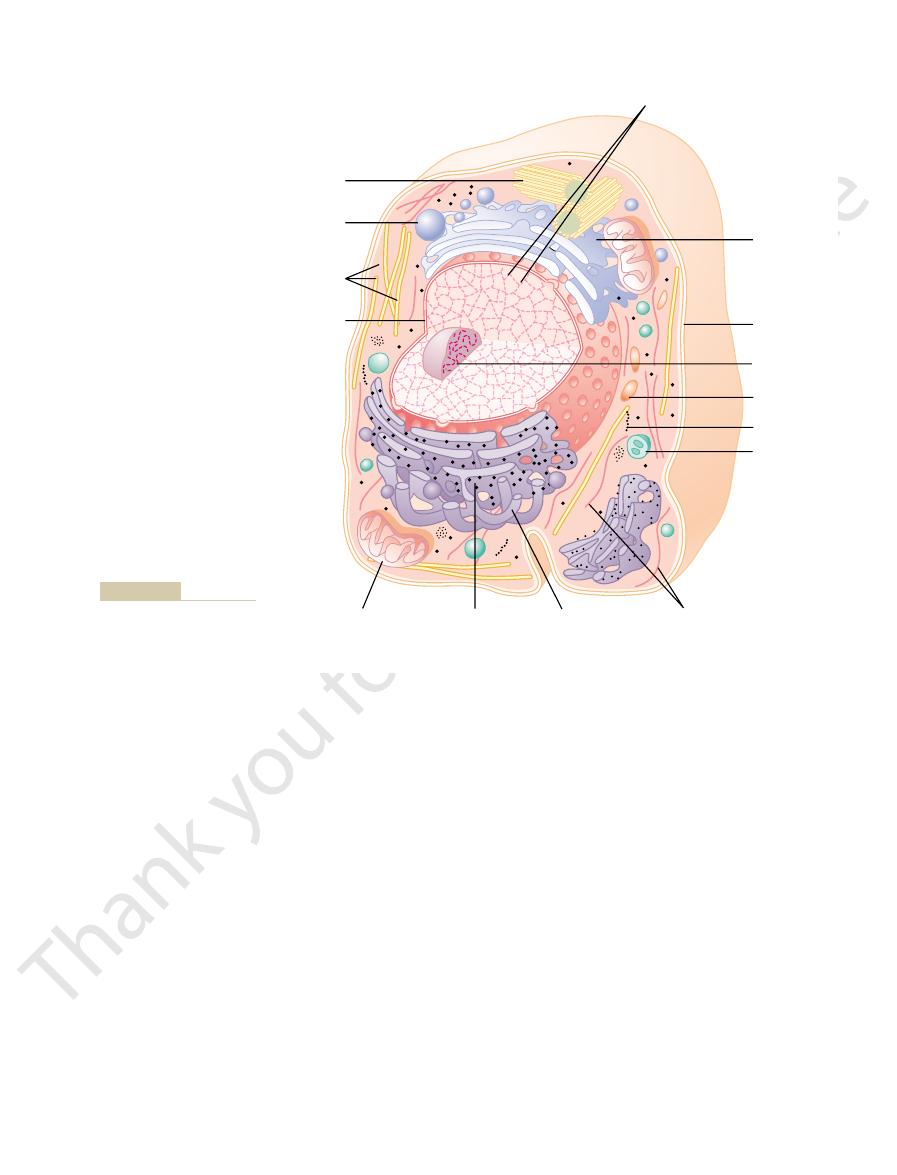
enzymes.
transport.” Still others act as
natural direction of diffusion, which is called “active
etrate the lipid bilayer. Sometimes these even trans-
stances over others.
fluids. These protein channels also have selective prop-
and water-soluble substances, especially ions, can
channels
all the way through the membrane, and
Two
glycoproteins.
brane proteins, most of which are
masses floating in the lipid bilayer. These are mem-
Figure 2–3 also shows globular
body fluids. Cholesterol controls much of the fluidity
ability) of the bilayer to water-soluble constituents of
in the bilayer of the membrane. They mainly help
fat soluble. These molecules, in a sense, are dissolved
The cholesterol molecules in the membrane are also
with ease.
alcohol, can penetrate this portion of the membrane
substances, such as oxygen, carbon dioxide, and
such as ions, glucose, and urea. Conversely, fat-soluble
impermeable to the usual water-soluble substances,
The lipid layer in the middle of the membrane is
water on the outside surface.
complete cell membrane, in contact with
brane, as shown in Figure 2–3. The hydrophilic phos-
attracted to one another, they have a natural tendency
the fatty acid portion is hydrophobic.
phosphate end of the phospholipid is hydrophilic, and
Chapter 2
The Cell and Its Functions
13
Because the hydrophobic portions of the phospho-
lipid molecules are repelled by water but are mutually
to attach to one another in the middle of the mem-
phate portions then constitute the two surfaces of the
intracellular
water on the inside of the membrane and extracellular
lipid in nature because their steroid nucleus is highly
determine the degree of permeability (or imperme-
of the membrane as well.
Cell Membrane Proteins.
types of proteins occur: integral proteins that protrude
peripheral pro-
teins that are attached only to one surface of the mem-
brane and do not penetrate all the way through.
Many of the integral proteins provide structural
(or pores) through which water molecules
diffuse between the extracellular and intracellular
erties that allow preferential diffusion of some sub-
Other integral proteins act as carrier proteins for
transporting substances that otherwise could not pen-
port substances in the direction opposite to their
Lysosome
Nucleolus
Cell
membrane
Secretory
granule
Mitochondrion
Centrioles
Microtubules
Nuclear
membrane
Granular
endoplasmic
reticulum
Smooth
(agranular)
endoplasmic
reticulum
Ribosomes
Glycogen
Golgi
apparatus
Microfilaments
Chromosomes and DNA
cell, showing the internal
Figure 2–2
Reconstruction of a typical
organelles in the cytoplasm
and in the nucleus.
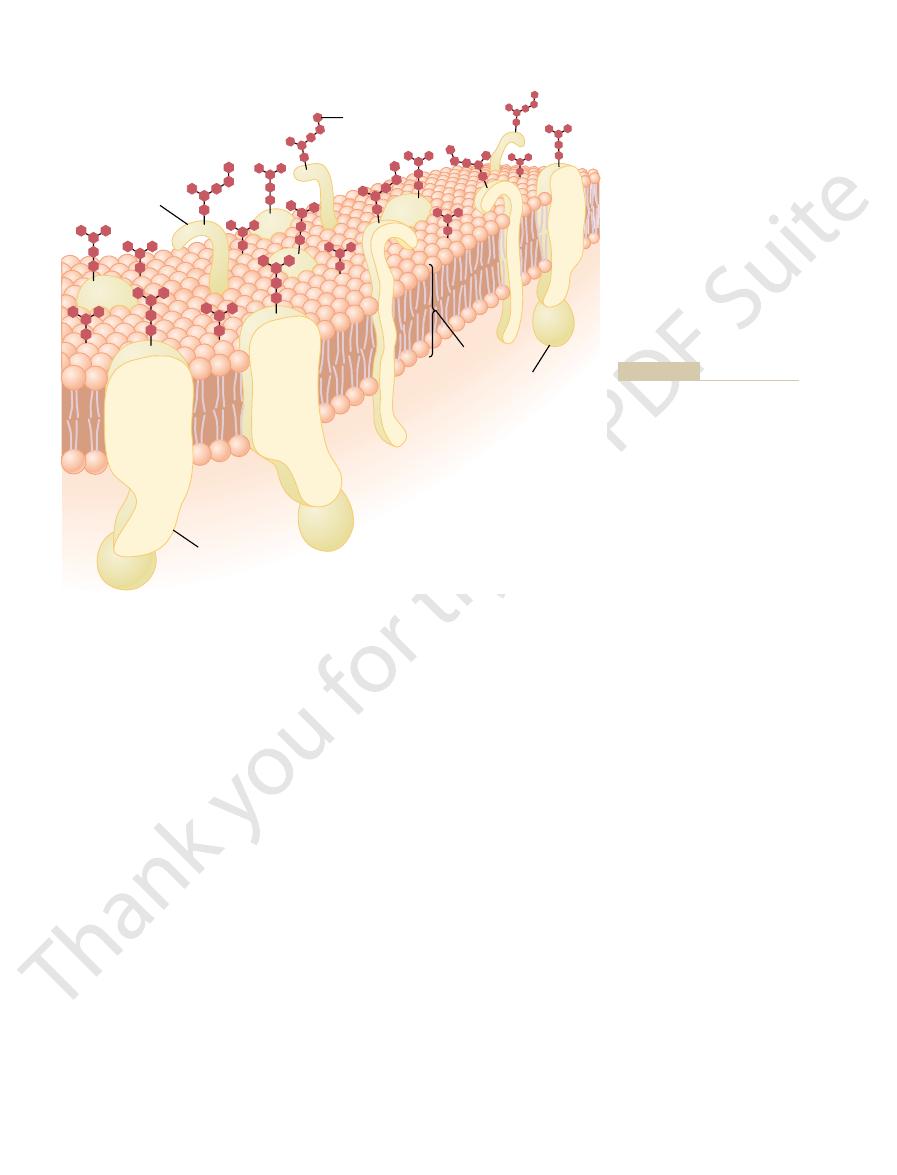
teins, electrolytes, and glucose.
of the cytoplasm in which the particles are dispersed
persed particles and organelles. The clear fluid portion
The cytoplasm is filled with both minute and large dis-
Cytoplasm and Its Organelles
immune reactions, as discussed in Chapter 34.
enzymes. (4) Some carbohydrate moieties enter into
that, in turn, activate a cascade of intracellular
for binding hormones, such as insulin; when bound,
other cells, thus attaching cells to one another. (3)
charge that repels other negative objects. (2) The gly-
(1) Many of them have a negative electrical charge,
The carbohydrate moieties attached to the outer
Thus, the entire outside surface of the cell often has a
cell surface. Many other carbohydrate compounds,
to the outside of the cell, dangling outward from the
membrane lipid molecules are glycolipids. The “glyco”
proteins are glycoproteins, and about one tenth of the
In fact, most of the integral
glycolipids.
“pores.”
the integral proteins. These peripheral proteins func-
environment to the cell interior.
this way, integral proteins spanning the cell membrane
lular part of the receptor to the interior of the cell. In
sengers,
and proteins in the cytoplasm that act as
tional changes in the receptor protein. This, in turn,
mones, that do not easily penetrate the cell membrane.
for water-soluble chemicals, such as peptide hor-
Introduction to Physiology: The Cell and General Physiology
14
Unit I
Integral membrane proteins can also serve as recep-
tors
Interaction of cell membrane receptors with specific
ligands that bind to the receptor causes conforma-
enzymatically activates the intracellular part of the
protein or induces interactions between the receptor
second mes-
thereby relaying the signal from the extracel-
provide a means of conveying information about the
Peripheral protein molecules are often attached to
tion almost entirely as enzymes or as controllers of
transport of substances through the cell membrane
Membrane Carbohydrates—The Cell “Glycocalyx.”
Mem-
brane carbohydrates occur almost invariably in
combination with proteins or lipids in the form of gly-
coproteins or
portions of these molecules almost invariably protrude
called proteoglycans—which are mainly carbohydrate
substances bound to small protein cores—are loosely
attached to the outer surface of the cell as well.
loose carbohydrate coat called the glycocalyx.
surface of the cell have several important functions:
which gives most cells an overall negative surface
cocalyx of some cells attaches to the glycocalyx of
Many of the carbohydrates act as receptor substances
this combination activates attached internal proteins
is called cytosol; this contains mainly dissolved pro-
Integral protein
Extracellular
fluid
Intracellular
fluid
Cytoplasm
Lipid
bilayer
Carbohydrate
Integral protein
Peripheral
protein
George V. Kevin.)
from Lodish HF, Rothman JE: The
and to additional protein mole-
attached to the protein molecules
Also, carbohydrate moieties are
protruding through the layer.
numbers of protein molecules
Structure of the cell membrane,
Figure 2–3
showing that it is composed
mainly of a lipid bilayer of phos-
pholipid molecules, but with large
on the outside of the membrane
cules on the inside. (Redrawn
assembly of cell membranes. Sci
Am 240:48, 1979. Copyright
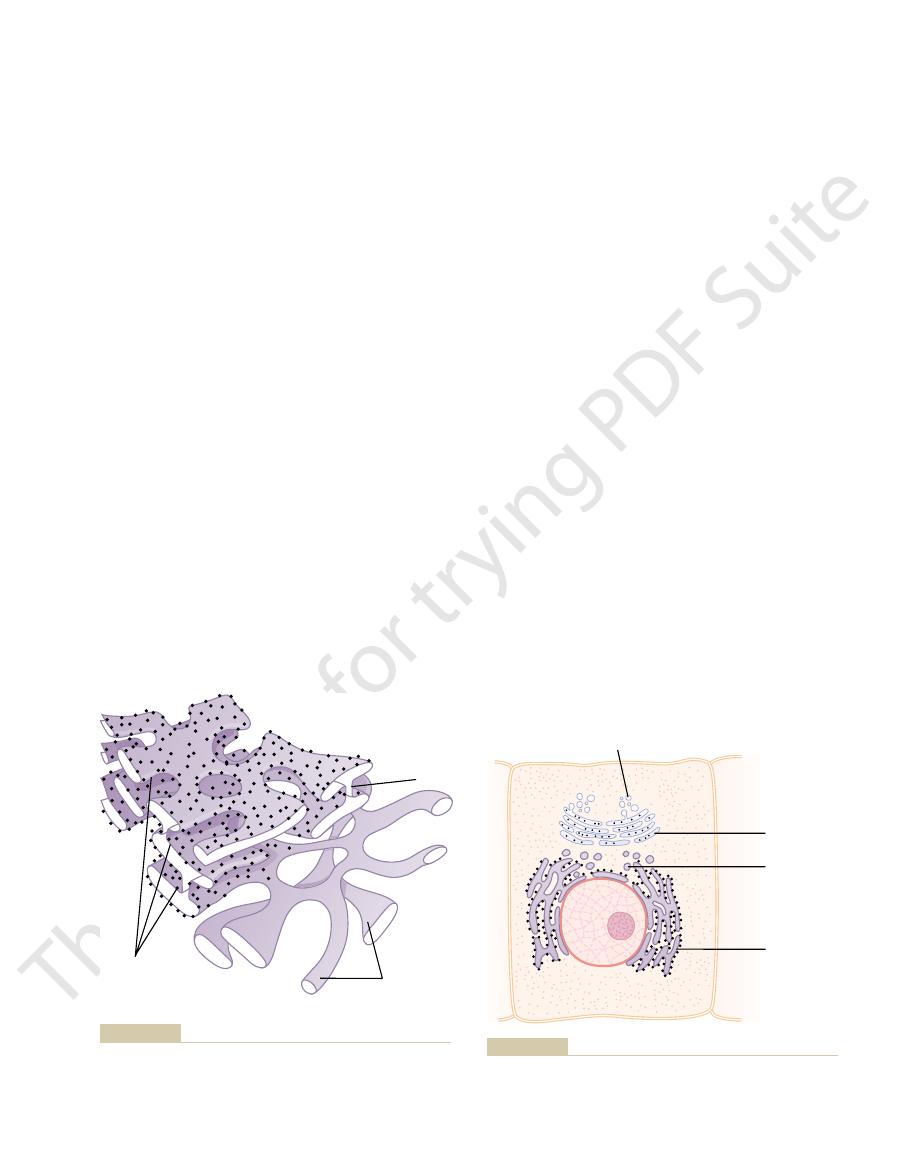
in the chapter.
other cytoplasmic components that are discussed later
apparatus to form lysosomes, secretory vesicles, and
endoplasmic reticulum to the Golgi apparatus. The
fuse with the Golgi apparatus. In this way, substances
reticulum vesicles, or
small “transport vesicles” (also called endoplasmic
the endoplasmic reticulum. As shown in Figure 2–5,
The Golgi apparatus functions in association with
in secretory cells, where it is located on the side of
one side of the nucleus. This apparatus is prominent
stacked layers of thin, flat, enclosed vesicles lying near
reticulum. It usually is composed of four or more
related to the endoplasmic reticulum. It has mem-
The Golgi apparatus, shown in Figure 2–5, is closely
cells promoted by intrareticular enzymes.
The agranular reticulum functions for the syn-
smooth, endoplasmic reticu-
agranular,
reticulum has no attached ribosomes. This part is
synthesize new protein molecules in the cell, as dis-
mixture of RNA and proteins, and they function to
The ribosomes are composed of a
present, the reticulum is called the
Where these are
ribosomes.
conducted to other parts of the cell. Also, the vast
membrane.
fluid in the cytosol outside the endoplasmic reticulum.
plasmic reticulum is shown in Figure 2–4. The space
The detailed structure of a small portion of endo-
cells, for instance—can be as much as 30 to 40 times
of proteins, similar to the cell membrane. The total
with one another. Also, their walls are constructed
The tubules and vesicles interconnect
ular structures in the cytoplasm; this is the
Figure 2–2 shows a network of tubular and flat vesic-
peroxisomes.
somes,
Golgi apparatus, mitochondria, lyso-
five especially important organelles: the
glycogen granules, ribosomes, secretory vesicles, and
Dispersed in the cytoplasm are neutral fat globules,
Chapter 2
The Cell and Its Functions
15
endoplasmic
reticulum, the
and
Endoplasmic Reticulum
endoplas-
mic reticulum.
of lipid bilayer membranes that contain large amounts
surface area of this structure in some cells—the liver
the cell membrane area.
inside the tubules and vesicles is filled with endoplas-
mic matrix, a watery medium that is different from the
Electron micrographs show that the space inside the
endoplasmic reticulum is connected with the space
between the two membrane surfaces of the nuclear
Substances formed in some parts of the cell enter
the space of the endoplasmic reticulum and are then
surface area of this reticulum and the multiple enzyme
systems attached to its membranes provide machinery
for a major share of the metabolic functions of the cell.
Ribosomes and the Granular Endoplasmic Reticulum.
Attached to the outer surfaces of many parts of the
endoplasmic reticulum are large numbers of minute
granular particles called
granular endoplas-
mic reticulum.
cussed later in this chapter and in Chapter 3.
Agranular Endoplasmic Reticulum.
Part of the endoplasmic
called the
or
lum.
thesis of lipid substances and for other processes of the
Golgi Apparatus
branes similar to those of the agranular endoplasmic
the cell from which the secretory substances are
extruded.
ER vesicles) continually pinch off
from the endoplasmic reticulum and shortly thereafter
entrapped in the ER vesicles are transported from the
transported substances are then processed in the Golgi
Matrix
Agranular
endoplasmic
reticulum
Granular
endoplasmic
reticulum
tis EDP, Saez FA, DeRobertis EMF: Cell Biology, 6th ed. Philadel-
Structure of the endoplasmic reticulum. (Modified from DeRober-
Figure 2–4
phia: WB Saunders, 1975.)
Golgi
apparatus
Endoplasmic
reticulum
ER vesicles
Golgi vesicles
reticulum (ER) and the nucleus.
A typical Golgi apparatus and its relationship to the endoplasmic
Figure 2–5
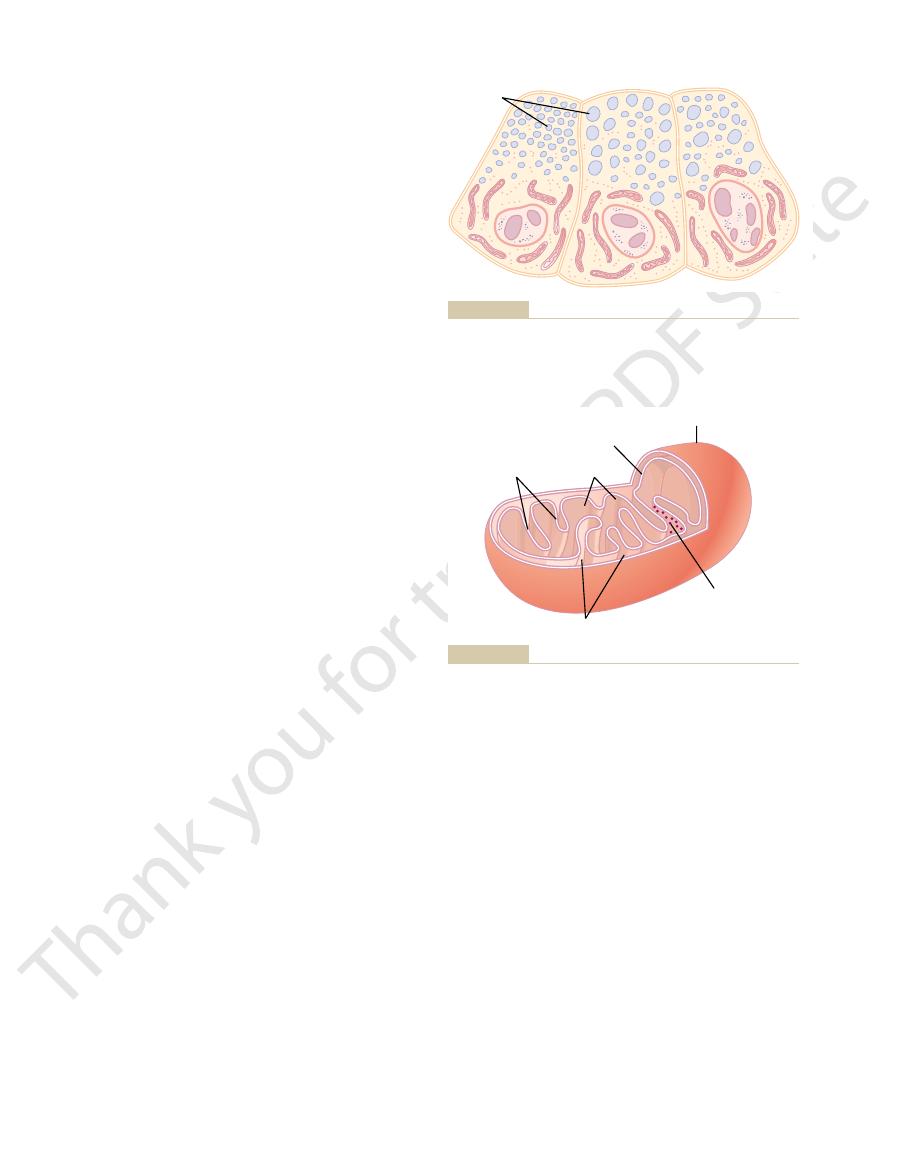
and shape. Some are only a few hundred nanometers
its energy metabolism. They are also variable in size
on the amount of energy required by the cell. Further,
less than a hundred up to several thousand, depending
cytoplasm, but the total number per cell varies from
Mitochondria are present in all areas of each cell’s
would cease.
the nutrients, and essentially all cellular functions
called the “powerhouses” of the cell. Without them,
The mitochondria, shown in Figures 2–2 and 2–7, are
duct and thence into the duodenum, where they
not yet activated). The proenzymes are secreted later
tory vesicles inside pancreatic acinar cells; these
Figure 2–6 shows typical secre-
secretory granules.
released from the Golgi apparatus into the cytoplasm
tion of special chemical substances. Almost all such
Secretory Vesicles
liver cells in this manner.
sonous to the cell. For instance, about half the alcohol
enzyme present in large quantities in peroxisomes, to
catalase,
). Hydro-
they contain oxidases rather than hydrolases. Several
lum) rather than from the Golgi apparatus. Second,
they are different in two important ways. First, they are
Peroxisomes are similar physically to lysosomes, but
Peroxisomes
somes are discussed later in the chapter.
glucose. Some of the more specific functions of lyso-
tive enzymes. These enzymes then split the organic
some of the lysosomes, allowing release of the diges-
therefore, prevents their digestive actions. However,
Ordinarily, the membrane surrounding the lysosome
hydrolyzed to form glucose, and lipids are hydrolyzed
is hydrolyzed to form amino acids, glycogen is
other part of the compound. For instance, protein
lase (digestive) enzymes.
granules 5 to 8 nanometers in diameter, which are
in diameter. It is surrounded by a typical lipid bilayer
types of cells, but it is usually 250 to 750 nanometers
bacteria. The lysosome is quite different in different
ingested by the cell, and (3) unwanted matter such as
lular structures, (2) food particles that have been
plasm. The lysosomes provide an
apparatus and then dispersing throughout the cyto-
Lysosomes, shown in Figure 2–2, are vesicular
Lysosomes
Introduction to Physiology: The Cell and General Physiology
16
Unit I
organelles that form by breaking off from the Golgi
intracellular digestive
system that allows the cell to digest (1) damaged cel-
membrane and is filled with large numbers of small
protein aggregates of as many as 40 different hydro-
A hydrolytic enzyme is
capable of splitting an organic compound into two or
more parts by combining hydrogen from a water mol-
ecule with one part of the compound and combining
the hydroxyl portion of the water molecule with the
to form fatty acids and glycerol.
prevents the enclosed hydrolytic enzymes from
coming in contact with other substances in the cell and,
some conditions of the cell break the membranes of
substances with which they come in contact into small,
highly diffusible substances such as amino acids and
believed to be formed by self-replication (or perhaps
by budding off from the smooth endoplasmic reticu-
of the oxidases are capable of combining oxygen with
hydrogen ions derived from different intracellular
chemicals to form hydrogen peroxide (H
2
O
2
gen peroxide is a highly oxidizing substance and is
used in association with
another oxidase
oxidize many substances that might otherwise be poi-
a person drinks is detoxified by the peroxisomes of the
One of the important functions of many cells is secre-
secretory substances are formed by the endoplasmic
reticulum–Golgi apparatus system and are then
in the form of storage vesicles called secretory vesicles
or
vesicles store protein proenzymes (enzymes that are
through the outer cell membrane into the pancreatic
become activated and perform digestive functions on
the food in the intestinal tract.
Mitochondria
cells would be unable to extract enough energy from
the mitochondria are concentrated in those portions
of the cell that are responsible for the major share of
Secretory
granules
pancreas.
Secretory granules (secretory vesicles) in acinar cells of the
Figure 2–6
Outer membrane
Inner membrane
Oxidative
phosphorylation
enzymes
Outer chamber
Matrix
Crests
Saez FA, DeRobertis EMF: Cell Biology, 6th ed. Philadelphia: WB
Structure of a mitochondrion. (Modified from DeRobertis EDP,
Figure 2–7
Saunders, 1975.)

reticulum, as shown in Figure 2–9.
with the endoplasmic reticulum of the cell cytoplasm,
inside the other. The outer membrane is continuous
is actually two separate bilayer membranes, one
lope,
nuclear membrane,
The
illustrated in the next chapter.
then be easily identified using the light microscope, as
chromosomes,
During mitosis, the chromatin material organizes in
chromatin material
period between mitoses), revealing darkly staining
activities. Figure 2–9 shows the light microscopic
Unfortunately, the appearance of the nucleus under
detail in the next chapter.
of which receives one of the two sets of DNA genes.
to form two daughter cells, each
identical sets of genes; then the cell splits by a special
the cell itself. The genes first reproduce to give two
The genes also control and promote reproduction of
plasmic and nuclear activities.
well as the intracellular enzymes that control cyto-
the cell’s proteins, including the structural proteins, as
The genes determine the characteristics of
genes.
nucleus contains large quantities of DNA, which are
The nucleus is the control center of the cell. Briefly, the
certain parts of cells.
Thus, a primary function of microtubules is to act as
composed of stiff microtubules.
and is illustrated in Figure 2–17. Also, both the
cilium. This structure is discussed later in the chapter
ates upward from the cell cytoplasm to the tip of the
Figure 2–8 shows typical microtubules that were
microtubules.
struct very strong tubular structures, the
traction, as discussed in detail in Chapter 6.
support for the cell membrane. Also, in muscle cells,
the cytoplasm, called the
As an example, large numbers of
filaments.
cytoplasm. The precursor molecules then polymerize
into filaments or tubules. These originate as precursor
The fibrillar proteins of the cell are usually organized
Filament and Tubular Structures of the Cell
controlling replication of the mitochondrion itself.
The DNA of the mitochondrion plays a similar role,
In Chapter 3 we will see that DNA is the basic chem-
similar to that found in the cell nucleus.
DNA
increased amounts of ATP. Indeed, the mitochondria
and so on, whenever there is a need in the cell for
one mitochondrion can form a second one, a third one,
Mitochondria are self-replicative, which means that
are introduced later in this chapter.
67, but some of the basic functions of ATP in the cell
forming cellular functions.The chemical details of ATP
release its own energy wherever it is needed for per-
mitochondrion, and it diffuses throughout the cell to
ATP is then transported out of the
triphosphate (ATP).
synthesize a “high-energy” substance called
time releasing energy. The liberated energy is used to
the shelves to cause oxidation of the nutrients, thereby
extracting energy from nutrients. These enzymes
are attached. In addition, the inner cavity of the mito-
inner membrane.
bilayer–protein membranes: an
in Figure 2–7, is composed mainly of two lipid
The basic structure of the mitochondrion, shown
filamentous.
7 micrometers long; still others are branching and
in diameter and globular in shape, whereas others are
Chapter 2
The Cell and Its Functions
17
elongated—as large as 1 micrometer in diameter and
outer membrane and
an
Many infoldings of the inner
membrane form shelves onto which oxidative enzymes
chondrion is filled with a matrix that contains large
quantities of dissolved enzymes that are necessary for
operate in association with the oxidative enzymes on
forming carbon dioxide and water and at the same
adenosine
formation by the mitochondrion are given in Chapter
contain
ical of the nucleus that controls replication of the cell.
protein molecules synthesized by ribosomes in the
to form
actin filaments frequently occur in the outer zone of
ectoplasm, to form an elastic
actin and myosin filaments are organized into a special
contractile machine that is the basis for muscle con-
A special type of stiff filament composed of poly-
merized tubulin molecules is used in all cells to con-
teased from the flagellum of a sperm.
Another example of microtubules is the tubular
skeletal structure in the center of each cilium that radi-
centri-
oles and the mitotic spindle of the mitosing cell are
a cytoskeleton, providing rigid physical structures for
Nucleus
the
process called mitosis
All these activities of the nucleus are considered in
the microscope does not provide many clues to the
mechanisms by which the nucleus performs its control
appearance of the interphase nucleus (during the
throughout the nucleoplasm.
the form of highly structured
which can
Nuclear Membrane
also called the nuclear enve-
and the space between the two nuclear membranes is
also continuous with the space inside the endoplasmic
formerly the Ciba Foundation.)
1967. Figure 4, page 314. Copyright the Novartis Foundation
Wolstenholme GEW, O’Connor M, and The publisher, JA Churchill,
Microtubules teased from the flagellum of a sperm. (From
Figure 2–8
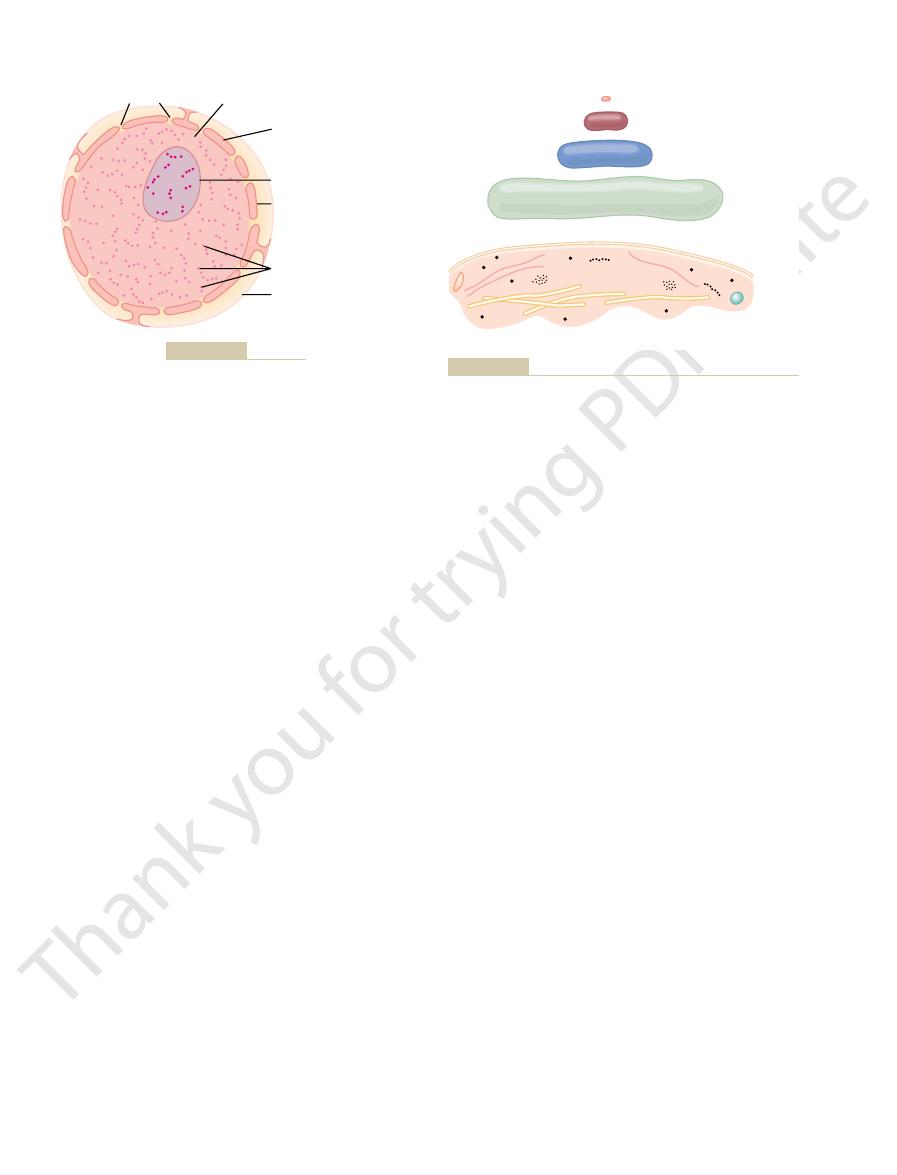
exactly the same structure as its progenitor.
tion after generation, each new cell having almost
vides a control center for all cellular activities, and it
of cell from all lower forms of life; the nucleus pro-
itself. The nucleus distinguishes this type
organelles developed, the most important of which is
Finally, in the nucleated cell, still more complex
the organism, representing physical structures of
ettsial and bacterial stages,
In still later stages of life, particularly in the rick-
mining the organism’s activities.
catalyzing chemical reactions and, therefore, deter-
matrix appeared. Specialized chemicals then devel-
around the virus, and inside the membrane, a fluid
in different parts of the virus. A membrane formed
organism, and specialized functions began to develop
As life evolved, other chemicals besides nucleic acid
human being are living structures.
appropriate conditions. Thus, the virus propagates its
cells, and it is capable of reproducing itself under
acid constituents (DNA or RNA) found in mammalian
This nucleic acid is composed of the same basic nucleic
The essential life-giving constituent of the small
cell are also far more complex than those of the virus.
ingly, the functions and anatomical organization of the
billion times that of the smallest virus. Correspond-
of the smallest virus and, therefore, a volume about 1
rickettsia,
smallest known virus, (2) a large virus, (3) a
earth. Figure 2–10 shows the relative sizes of (1) the
virus,
develop after the earliest form of life, an organism
However, the cell is a very complicated organism that
Many of us think of the cell as the lowest level of life.
with Precellular Forms of Life
forming cytoplasmic proteins, as discussed more fully
“mature” ribosomes that play an essential role in
through the nuclear pores into cytoplasm. Here, it is
in the nucleoli, but most of it is transported outward
cause RNA to be synthesized. Some of this is stored
nucleus. First, specific DNA genes in the chromosomes
the cytoplasm outside the nucleus) begins in the
Formation of the nucleoli (and of the ribosomes in
ing proteins.
types found in ribosomes. The nucleolus becomes con-
mulation of large amounts of RNA and proteins of the
have a limiting membrane. Instead, it is simply an accu-
unlike most other organelles discussed here, does not
The nucleolus,
The nuclei of most cells contain one or more highly
Nucleoli and Formation of Ribosomes
pass through with reasonable ease.
nanometers in diameter. Even this size is large enough
nuclear pores.
The nuclear membrane is penetrated by several
Introduction to Physiology: The Cell and General Physiology
18
Unit I
thousand
Large complexes of protein
molecules are attached at the edges of the pores so
that the central area of each pore is only about 9
to allow molecules up to 44,000 molecular weight to
staining structures called nucleoli.
siderably enlarged when the cell is actively synthesiz-
used in conjunction with specific proteins to assemble
in Chapter 3.
Comparison of the Animal Cell
required many hundreds of millions of years to
similar to the present-day
first appeared on
(4) a bacterium, and (5) a nucleated cell, demonstrat-
ing that the cell has a diameter about 1000 times that
virus is a nucleic acid embedded in a coat of protein.
lineage from generation to generation and is therefore
a living structure in the same way that the cell and the
and simple proteins became integral parts of the
oped inside the fluid to perform special functions;
many protein enzymes appeared that were capable of
organelles developed inside
chemical aggregates that perform functions in a more
efficient manner than can be achieved by dispersed
chemicals throughout the fluid matrix.
the nucleus
provides for exact reproduction of new cells genera-
Nuclear envelope –
Endoplasmic
reticulum
Nucleoplasm
Cytoplasm
outer and inner
membranes
Pores
Nucleolus
Chromatin material (DNA)
Structure of the nucleus.
Figure 2–9
15 nm — Small virus
150 nm — Large virus
350 nm — Rickettsia
1
m
m Bacterium
5 – 10
m
m
+
Cell
average cell in the human body.
Comparison of sizes of precellular organisms with that of the
Figure 2–10

a second to surround the entire particle; then,
2. The edges of the membrane around the points of
ligands of the particle.
1. The cell membrane receptors attach to the surface
Phagocytosis occurs in the following steps:
terium along with it. This intermediation of antibodies
attaches to the phagocyte receptors, dragging the bac-
to a specific antibody, and it is the antibody that
of bacteria, each bacterium usually is already attached
receptors on the surface of the phagocyte. In the case
bacterium, a dead cell, or tissue debris binds with
Phagocytosis is initiated when a particle such as a
tissue macrophages and some of the white blood cells.
have the capability of phagocytosis, most notably the
particles rather than molecules. Only certain cells
way as pinocytosis, except that it involves large
Phagocytosis occurs in much the same
membrane.
cellular fluid, which probably react with contractile
energy substance discussed later in the chapter. Also,
from within the cell; this is supplied by ATP, a high-
remains mainly a mystery. This process requires energy
necessary contortions to form pinocytotic vesicles
What causes the cell membrane to go through the
inside the cytoplasm of the cell.
from the surface of the cell, forming a
amount of extracellular fluid. Immediately thereafter,
invaginates inward, and the fibrillar proteins sur-
with the receptors, the surface properties of the local
teins, perhaps including contractile filaments of
coated pits.
the cell membrane, called
protein that is to be absorbed. The receptors generally
attaching to the membrane. These molecules usually
pinocytosis, showing three molecules of protein
Figure 2–11 demonstrates the successive steps of
molecules attach to the cell membrane.
enter cells. In fact, the rate at which pinocytotic vesi-
macromolecules, such as most protein molecules, can
Pinocytosis is the only means by which most large
tron microscope.
each minute. Even so, the pinocytotic vesicles are so
in some cells. For instance, it occurs so rapidly in
membranes of most cells, but it is especially rapid
Pinocytosis occurs continually in the cell
tissue.
as bacteria, whole cells, or portions of degenerating
Phagocytosis means ingestion of large particles, such
particulate constituents inside the cell cytoplasm.
Pinocytosis means ingestion of minute
phagocytosis.
principal forms of endocytosis are
The
endocytosis.
Very large particles enter the cell by a specialized
membrane. These active transport mechanisms are so
membrane.
soluble substances, through the lipid matrix of the
through cell membrane pores or, in the case of lipid-
ecules of the substance; substances move either
rounding fluids. Most substances pass through the cell
obtain nutrients and other substances from the sur-
If a cell is to live and grow and reproduce, it must
In the remainder of this chapter, we discuss several
Chapter 2
The Cell and Its Functions
19
Functional Systems of the Cell
representative functional systems of the cell that make
it a living organism.
Ingestion by the Cell—Endocytosis
membrane by diffusion and active transport.
Diffusion involves simple movement through the
membrane caused by the random motion of the mol-
Active transport involves the actual carrying of a
substance through the membrane by a physical pro-
tein structure that penetrates all the way through the
important to cell function that they are presented in
detail in Chapter 4.
function of the cell membrane called
pinocytosis and
particles that form vesicles of extracellular fluid and
Pinocytosis.
macrophages that about 3 per cent of the total macro-
phage membrane is engulfed in the form of vesicles
small—usually only 100 to 200 nanometers in diame-
ter—that most of them can be seen only with the elec-
cles form is usually enhanced when such macro-
attach to specialized protein receptors on the surface
of the membrane that are specific for the type of
are concentrated in small pits on the outer surface of
On the inside of
the cell membrane beneath these pits is a latticework
of fibrillar protein called clathrin, as well as other pro-
actin
and myosin. Once the protein molecules have bound
membrane change in such a way that the entire pit
rounding the invaginating pit cause its borders to close
over the attached proteins as well as over a small
the invaginated portion of the membrane breaks away
pinocytotic
vesicle
it requires the presence of calcium ions in the extra-
protein filaments beneath the coated pits to provide
the force for pinching the vesicles away from the cell
Phagocytosis.
is called opsonization, which is discussed in Chapters
33 and 34.
attachment evaginate outward within a fraction of
progressively more and more membrane receptors
Receptors
Actin and myosin
Dissolving clathrin
Proteins
Coated pit
Clathrin
A
B
C
D
Figure 2–11
Mechanism of pinocytosis.
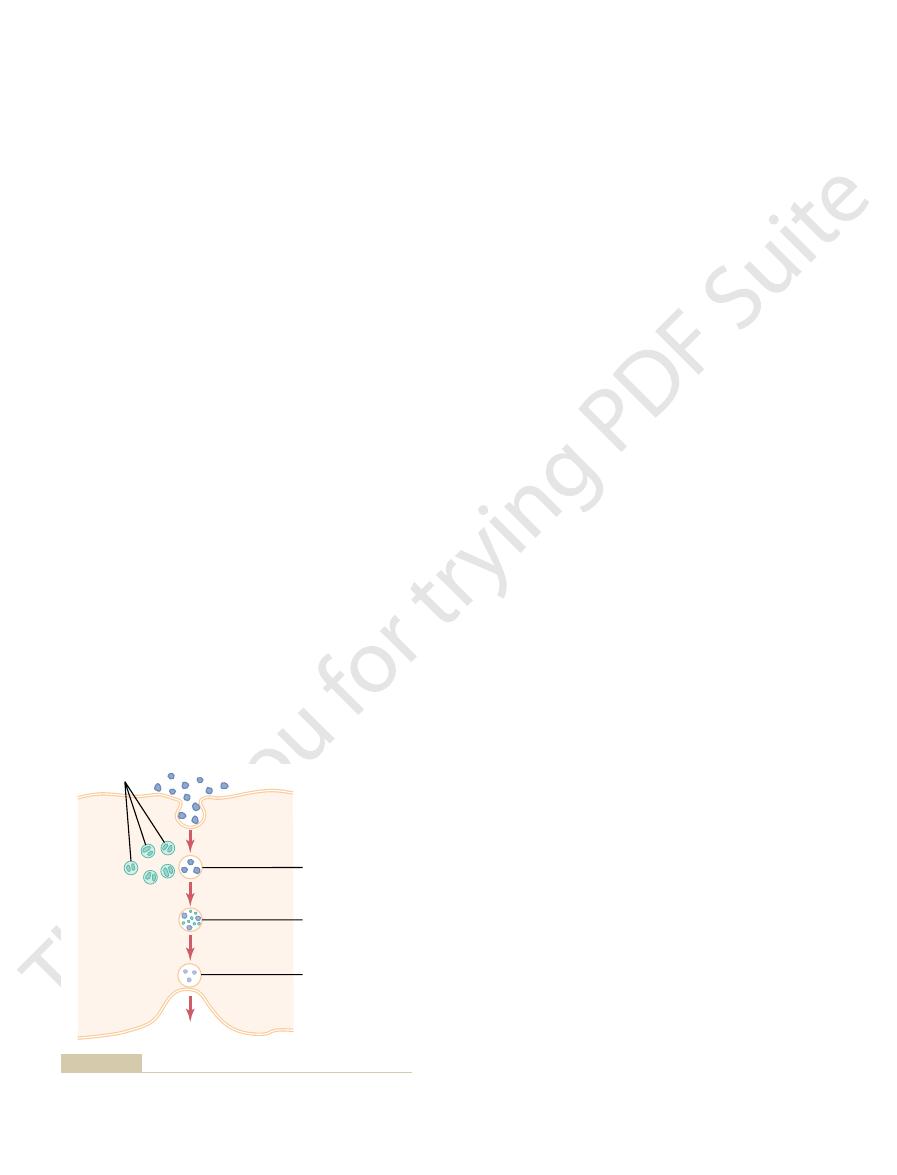
vesicles and tubules, that is, into the
protein molecules directly into the cytosol, but they
somes. The ribosomes extrude some of the synthesized
membrane. As we discuss in Chapter 3, protein mole-
The granular portion of the endoplasmic reticulum is
Golgi apparatus.
before being released into the cytoplasm. But first, let
Golgi apparatus, where they are further processed
The products formed there are then passed on to the
lipid bilayer membranes similar to the cell membrane,
emphasized. These structures are formed primarily of
The extensiveness of the endoplasmic reticulum and
and Golgi Apparatus
Synthesis and Formation of Cellular
inactivates bacterial metabolic systems.
pH of about 5.0, which activates the hydrolases and
they can promote bacterial growth; and (3) acid at a
which dissolves the bacterial cell membrane; (2)
lysozyme,
cellular damage. These agents include (1)
can kill phagocytized bacteria before they can cause
The lysosomes also contain bactericidal agents that
cell to take the place of the old one.
pletely removed, and a new cell of the same type ordi-
In this way, the cell is com-
autolysis.
the damage is severe, the entire cell is digested, a
the cell is removed, followed by repair of the cell. If
substances. If the damage is slight, only a portion of
somes to rupture. The released hydrolases immedi-
trauma, chemicals, or any other factor—induces lyso-
tissues. Damage to the cell—caused by heat, cold,
much of this regression. The mechanism by which lack
the end of lactation. Lysosomes are responsible for
long periods of inactivity, and in mammary glands at
occurs in the uterus after pregnancy, in muscles during
body often regress to a smaller size. For instance, this
Tissues of the
Regression of Tissues and Autolysis of Cells.
the cells.
Thus, the pinocytotic and phagocytic vesicles con-
opposite of endocytosis.
exocytosis,
represents indigestible substances. In most instances,
residual body,
left of the digestive vesicle, called the
membrane of the vesicle into the cytoplasm. What is
phosphates, and so forth that can diffuse through the
digestion are small molecules of amino acids, glucose,
and other substances in the vesicle. The products of
begin hydrolyzing the proteins, carbohydrates, lipids,
the cell cytoplasm in which the vesicular hydrolases
Figure 2–12. Thus, a
to the inside of the vesicle, as shown in
vesicle appears inside a cell, one or more
Almost immediately after a pinocytotic or phagocytic
the Cell—Function of the Lysosomes
Digestion of Pinocytotic and
pinocytotic vesicles are formed.
separates from the cell membrane, leaving the
4. The contractile proteins then pinch the stem of
interior.
around its outer edge, pushing the vesicle to the
surround the phagocytic vesicle and contract
3. Actin and other contractile fibrils in the cytoplasm
phagocytic vesicle.
suddenly in a zipper-like manner to form a closed
attach to the particle ligands. All this occurs
Introduction to Physiology: The Cell and General Physiology
20
Unit I
the vesicle so completely that the vesicle
vesicle in the cell interior in the same way that
Phagocytic Foreign Substances Inside
lysosomes
become attached to the vesicle and empty their acid
hydrolases
digestive vesicle is formed inside
this is finally excreted through the cell membrane by
a process called
which is essentially the
taining lysosomes can be called the digestive organs of
of activity in a tissue causes the lysosomes to increase
their activity is unknown.
Another special role of the lysosomes is removal of
damaged cells or damaged portions of cells from
ately begin to digest the surrounding organic
process called
narily is formed by mitotic reproduction of an adjacent
lyso-
ferrin, which binds iron and other substances before
Structures by Endoplasmic Reticulum
Specific Functions of the
Endoplasmic Reticulum
the Golgi apparatus in secretory cells has already been
and their walls are loaded with protein enzymes that
catalyze the synthesis of many substances required by
the cell.
Most synthesis begins in the endoplasmic reticulum.
us note the specific products that are synthesized in
specific portions of the endoplasmic reticulum and the
Proteins Are Formed by the Granular Endoplasmic Reticulum.
characterized by large numbers of ribosomes attached
to the outer surfaces of the endoplasmic reticulum
cules are synthesized within the structures of the ribo-
also extrude many more through the wall of the endo-
plasmic reticulum to the interior of the endoplasmic
endoplasmic
matrix.
Lysosomes
Pinocytotic or
phagocytic
vesicle
Digestive vesicle
Residual body
Excretion
enzymes derived from lysosomes.
Figure 2–12
Digestion of substances in pinocytotic or phagocytic vesicles by

lar use.
Some vesicles, however, are destined for intracellu-
membrane’s outer surface and extrusion of its contents
brane, followed by exocytosis—that is, opening of the
entry of calcium ions into the cell; calcium ions inter-
Exocytosis, in most cases, is stimulated by the
cytosis.
membrane, then fuse with it and empty their sub-
brane. These secretory vesicles first diffuse to the cell
In a highly secretory cell, the
Vesicles and Lysosomes.
Types of Vesicles Formed by the Golgi Apparatus—Secretory
and within 1 to 2 hours, radioactive proteins are
proteins are already present in the Golgi apparatus,
within 3 to 5 minutes. Within 20 minutes, newly formed
acids, newly formed radioactive protein molecules can
When a glandular cell is bathed in radioactive amino
To give an idea of the timing of these processes:
turn, the vesicles diffuse throughout the cell.
with them the compacted secretory substances, and in
ually break away from the Golgi apparatus, carrying
proceed. Finally, both small and large vesicles contin-
Golgi apparatus, the compaction and processing
secretions into highly concentrated packets. As the
secretions. Also, an important function of the Golgi
the vesicular spaces of the Golgi apparatus. Here,
The transport vesicles instantly fuse with the Golgi
of the Golgi apparatus. Inside these
deepest layer
the Golgi apparatus. At this point, small
endoplasmic reticulum, especially the proteins, they
Golgi apparatus. As substances are formed in the
Figure 2–13 summarizes the
Formation of Vesicles.
cartilage and bone.
between collagen fibers and cells; and (3) they are
the cells in the interstitial spaces, acting as filler
in mucus and other glandular secretions; (2) they are
chondroitin sulfate in the body are as follows: (1) they
chondroitin sulfate.
bound with small amounts of protein; the most impor-
formed in the endoplasmic reticulum. This is especially
in the endoplasmic reticulum, it also has the capability
in other ways.
hydrolysis, conjugation with glycuronic acid, and
detoxification by coagulation, oxidation,
that might damage the cell. It achieves
capable of detoxifying substances, such as drugs,
2. It provides a vast number of enzymes that are
energy.
1. It provides the enzymes that control glycogen
cially the smooth reticulum, include the following:
nificant functions of the endoplasmic reticulum, espe-
migrate rapidly to the Golgi apparatus.
from the smooth reticulum; most of these vesicles then
beyond the needs of the cell, small vesicles called
To keep the endoplasmic reticulum from growing
reticulum to grow more extensive. This occurs mainly
plasmic reticulum itself, thus causing the endoplasmic
especially phospholipids and cholesterol. These are
The endoplasmic reticulum also synthesizes lipids,
Chapter 2
The Cell and Its Functions
21
Synthesis of Lipids by the Smooth Endoplasmic Reticulum.
rapidly incorporated into the lipid bilayer of the endo-
in the smooth portion of the endoplasmic reticulum.
ER
vesicles or transport vesicles continually break away
Other Functions of the Endoplasmic Reticulum.
Other sig-
breakdown when glycogen is to be used for
Specific Functions of the Golgi Apparatus
Synthetic Functions of the Golgi Apparatus.
Although the
major function of the Golgi apparatus is to provide
additional processing of substances already formed
of synthesizing certain carbohydrates that cannot be
true for the formation of large saccharide polymers
tant of these are hyaluronic acid and
A few of the many functions of hyaluronic acid and
are the major components of proteoglycans secreted
the major components of the ground substance outside
principal components of the organic matrix in both
Processing of Endoplasmic Secretions by the Golgi Apparatus—
major functions of the endoplasmic reticulum and
are transported through the tubules toward portions
of the smooth endoplasmic reticulum that lie nearest
transport vesi-
cles composed of small envelopes of smooth endo-
plasmic reticulum continually break away and diffuse
to the
vesicles are the synthesized proteins and other prod-
ucts from the endoplasmic reticulum.
apparatus and empty their contained substances into
additional carbohydrate moieties are added to the
apparatus is to compact the endoplasmic reticular
secretions pass toward the outermost layers of the
be detected in the granular endoplasmic reticulum
secreted from the surface of the cell.
vesicles formed by the Golgi apparatus are mainly
secretory vesicles containing protein substances that
are to be secreted through the surface of the cell mem-
stances to the exterior by the mechanism called exo-
act with the vesicular membrane in some way that is
not understood and cause its fusion with the cell mem-
outside the cell.
Transport
Ribosomes
Lysosomes
Secretory
vesicles
Protein
formation
Glycosylation
vesicles
Smooth
endoplasmic
reticulum
Golgi
apparatus
Granular
endoplasmic
reticulum
Lipid
formation
plasmic reticulum and Golgi apparatus.
Formation of proteins, lipids, and cellular vesicles by the endo-
Figure 2–13
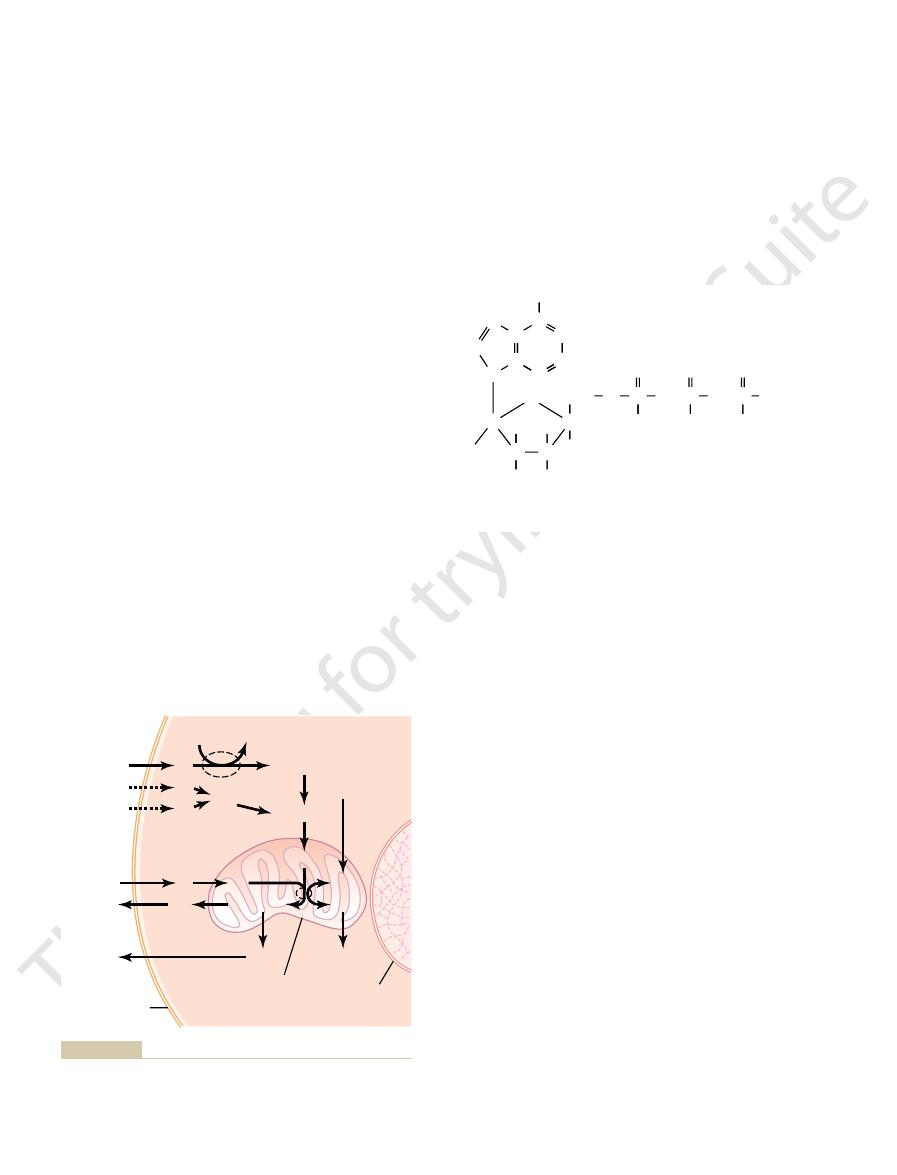
released during this conversion, but this amount
amount of ADP is changed into ATP by the energy
). A small
pyruvic acid
On entry into the cells, glucose is sub-
Chemical Processes in the Formation of ATP—Role of the
ually, having a turnover time of only a few minutes.
these reasons, ATP has been called the
and the entire process repeats over and over again. For
and phosphoric acid to recombine to form new ATP,
energy derived from the cellular nutrients causes ADP
To reconstitute the cellular ATP as it is used up,
tually all of the cell’s other functions, such as synthe-
is formed. This released energy is used to energize vir-
radical is split away, and
When ATP releases its energy, a phosphoric acid
other intracellular reactions.
bond is very labile, so that it can be split instantly on
Further, the high-energy phosphate
average chemical bond, thus giving rise to the term
12,000 calories of energy per mole of ATP, which is
body,
Under the physical and chemical conditions of the
high-energy phosphate bonds,
The last two phosphate rad-
phosphate radicals.
ribose,
adenine,
ATP is a nucleotide composed of (1) the nitrogenous
energy released in the proper direction. The details of
chemically with oxygen, under the influence of
ing the cell. Inside the cell, the foodstuffs react
stuffs—glucose, fatty acids, and amino acids—all enter-
Figure 2–14 shows oxygen and the food-
fatty acids.
before they reach the other cells of the body. Similarly,
human body, essentially all carbohydrates are con-
oxygen—carbohydrates, fats, and proteins. In the
The principal substances from which cells extract
Extraction of Energy from Nutrients—
In summary, the membranous system of the endo-
apparatus continually replenish the cell membrane.
totic vesicle, and the vesicular membranes of the Golgi
substance every time it forms a phagocytic or pinocy-
up. For instance, the cell membrane loses much of its
This increases the expanse of these membranes and
Use of Intracellular Vesicles to Replenish Cellular Membranes.
Introduction to Physiology: The Cell and General Physiology
22
Unit I
Some of the intracellular vesicles formed by the Golgi
apparatus fuse with the cell membrane or with the
membranes of intracellular structures such as the
mitochondria and even the endoplasmic reticulum.
thereby replenishes the membranes as they are used
plasmic reticulum and Golgi apparatus represents a
highly metabolic organ capable of forming new intra-
cellular structures as well as secretory substances to be
extruded from the cell.
Function of the Mitochondria
energy are foodstuffs that react chemically with
verted into glucose by the digestive tract and liver
proteins are converted into amino acids and fats into
enzymes that control the reactions and channel the
base
(2) the pentose sugar
and (3)
three
icals are connected with the remainder of the molecule
by so-called
which are
represented in the formula above by the symbol ~.
each of these high-energy bonds contains about
many times greater than the energy stored in the
high-energy bond.
demand whenever energy is required to promote
adenosine diphosphate (ADP)
sis of substances and muscular contraction.
energy currency
of the cell because it can be spent and remade contin-
Mitochondria.
jected to enzymes in the cytoplasm that convert it
into
(a process called glycolysis
36 ATP
2ADP
2ATP
ATP
Gl
Pyruvic acid
O
2
Amino acids
Cell
membrane
Fatty acids
Glucose
AA
FA
Acetoacetic
acid
Acetyl-CoA
Mitochondrion
Nucleus
CO
2
H
2
O
H
2
O
O
2
CO
2
Acetyl-CoA
ADP
36 ADP
O
2
CO
2
+H
2
O
that most of the ATP is formed in the mitochondria. ADP, adeno-
Formation of adenosine triphosphate (ATP) in the cell, showing
Figure 2–14
sine diphosphate.
OH
OH
P
O
O
O-
O-
O-
H
NH
2
H
N
N
N
C
C
C
N
C
C
C
O
C
H
H
O-
O
O
P
O
P
O
CH
2
CH
HC
~
~
~
~
Phosphate
Adenosine triphosphate
Adenine
Ribose
Functional Characteristics of ATP
quent intracellular metabolic reactions.
Then, ATP, not the original foodstuffs, is used
ATP.
inside the mitochondria, and the energy that is
Briefly, almost all these oxidative reactions occur
all these digestive and metabolic functions are given
in Chapters 62 through 72.
released is used to form the high-energy compound
throughout the cell to energize almost all the subse-
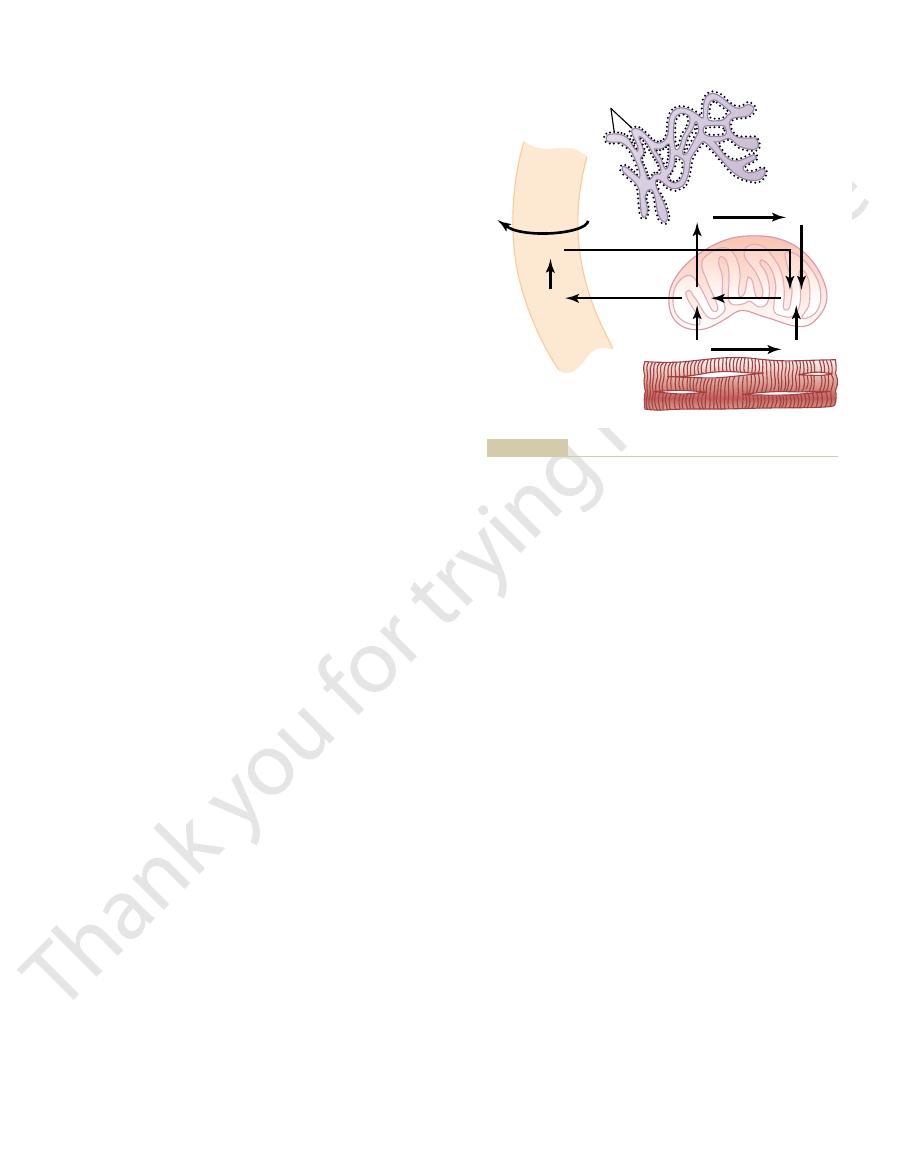
cell it is needed. To replace the ATP used by the cell,
In summary, ATP is always available to release its
energy for all these types of mechanical work is ATP.
are described later in this chapter. The source of
ways, especially by
energy. Other cells perform mechanical work in other
requires expenditure of tremendous quantities of ATP
special cells to perform mechanical work. We see in
The final major use of ATP is to supply energy for
the growth phase of cells.
cially protein molecules; this is particularly true during
simply to synthesize new chemical compounds, espe-
much as 75 per cent of all the ATP formed in the cell
protein molecule is formed. Indeed, some cells use as
ATP molecules must release their energy as each
down of four high-energy bonds; thus, many thousand
another by peptide linkages; the formation of each of
chemical compound requires energy. For instance, a
host of other substances. Synthesis of almost any
phospholipids, cholesterol, purines, pyrimidines, and a
In addition to synthesizing proteins, cells synthesize
for this purpose alone.
use as much as 80 per cent of the ATP that they form
that some cells—the renal tubular cells, for instance—
and many other ions and various organic substances.
phate ions, chloride ions, urate ions, hydrogen ions,
of potassium ions, calcium ions, magnesium ions, phos-
energy from ATP is required for membrane transport
protein synthesis by the ribosomes, and (3) to supply
of sodium through the cell membrane, (2) to promote
in Figure 2–15: (1) to supply energy for the transport
These uses of ATP are illustrated by examples
mechanical
throughout the cell, and (3)
synthesis of chemical
membranes in the cell, (2)
functions: (1)
Energy from ATP is
Uses of ATP for Cellular Function.
metabolic functions of ATP in the body are presented
presented in Chapter 67, and many of the detailed
of ATP formation. The
chemiosmotic mechanism
This overall process for formation of ATP is called
energize multiple cell functions.
plasm and nucleoplasm, where its energy is used to
out of the mitochondria into all parts of the cell cyto-
ADP to ATP. The newly formed ATP is transported
Finally, the enzyme ATP synthetase uses the energy
from the membranes of the mitochondrial shelves.
ATP synthetase,
teins, called
ion. The terminal event is combination of hydrogen
the hydrogen atom, thus converting it to a hydrogen
matrix. The initial event is removal of an electron from
ATP. The processes of these reactions are complex,
chondria to convert very large amounts of ADP to
dous amount of energy, which is used by the mito-
diffused into the mitochondria. This releases a tremen-
The hydrogen atoms, conversely, are highly reactive,
from the body through the lungs.
and eventually out of the cell; finally, it is excreted
The carbon dioxide diffuses out of the mitochondria
carbon dioxide.
component parts,
In this citric acid cycle, acetyl-CoA is split into its
These chemical reactions are
Krebs cycle.
cycle,
mitochondrion matrix, undergoing dissolution in a
turn, is further dissoluted (for the purpose of extract-
in the matrix of the mitochondrion. This substance, in
acids from lipids, and amino acids from proteins are
The pyruvic acid derived from carbohydrates, fatty
cell, about 95 per cent, is formed in the mitochondria.
By far, the major portion of the ATP formed in the
Chapter 2
The Cell and Its Functions
23
accounts for less than 5 per cent of the overall energy
metabolism of the cell.
eventually converted into the compound acetyl-CoA
ing its energy) by another series of enzymes in the
sequence of chemical reactions called the citric acid
or
so important that they are explained in detail in
Chapter 67.
hydrogen atoms and
and they combine instantly with oxygen that has also
requiring the participation of large numbers of protein
enzymes that are integral parts of mitochondrial mem-
branous shelves that protrude into the mitochondrial
ions with oxygen to form water plus the release of
tremendous amounts of energy to large globular pro-
that protrude like knobs
from the hydrogen ions to cause the conversion of
the
chemical and physical details of this mechanism are
in Chapters 67 through 71.
used to promote three major categories of cellular
transport of substances through multiple
compounds
work.
the energy needed during muscle contraction.
In addition to membrane transport of sodium,
Membrane transport is so important to cell function
single protein molecule might be composed of as many
as several thousand amino acids attached to one
these linkages requires energy derived from the break-
Chapter 6 that each contraction of a muscle fiber
ciliary and ameboid motion, which
energy rapidly and almost explosively wherever in the
ATP
ADP
ATP
ATP
ATP
ADP
Mitochondrion
ADP
Na
+
Na
+
Muscle contraction
ADP
Protein synthesis
Ribosomes
Membrane
transport
Endoplasmic
reticulum
brane transport, protein synthesis, and muscle contraction. ADP,
drion) to provide energy for three major cellular functions: mem-
Use of adenosine triphosphate (ATP) (formed in the mitochon-
Figure 2–15
adenosine diphosphate.

whiplike movement of cilia on the surfaces of cells. This
ciliary movement,
certain, it is known that the side of the cell most exposed
ameboid locomotion? Although the answer is not
tive chemotaxis.
cells move away from the source, which is called
positive chemotaxis.
source of a chemotactic substance—that is, from an area
chemotactic substance.
ance of certain chemical substances in the tissues.
This results from the appear-
chemotaxis.
The most
development of special structures.
instance, embryonic cells often must migrate long dis-
embryo and fetus after fertilization of an ovum. For
toward a cut area to repair the rent. Finally, cell loco-
skin, though ordinarily completely sessile cells, move
repair the damage, and even the germinal cells of the
instance, fibroblasts move into a damaged area to help
ameboid locomotion under certain circumstances. For
macrophages.
The most
Types of Cells That Exhibit Ameboid Locomotion.
membrane.
the ectoplasm of the cell body, where a preexisting
enlarging pseudopodium. Contraction also occurs in
the pseudopodium of a moving cell, where such
high-energy compound ATP. This is what happens in
The whole process is energized by the
merize to form a filamentous network, and the network
do not provide any motive power; however, these poly-
the following as an explanation: In the cytoplasm of all
direction of the pseudopodium. Experiments suggest
The second essential effect for locomotion is to
the pseudopodial end of the cell, where they are used
cles. Then, inside the cell, these vesicles stream toward
away from their ligands and form new endocytotic vesi-
At the opposite end of the cell, the receptors pull
and attach to ligands in the surrounding tissues.
outside, and the receptors now protrude to the outside
membrane, they open so that their insides evert to the
cles. When the vesicles become part of the pseudopodial
that line the insides of exocytotic vesi-
point of attachment. This attachment is effected by
that it becomes fixed in its leading position, while the
forward movement of the cell. The first effect is attach-
of the cell. Also, two other effects are essential for
general principle of ameboid motion. Basically, it results
Figure 2–16 shows the
following along as the cell moves.
end of the cell is continually moving forward, and the
is a protruding pseudopodium. The membrane of this
showing an elongated cell, the right-hand end of which
pseudopodium. Figure 2–16 demonstrates this process,
Then the remainder of the cell is pulled toward the
body, and partially secures itself in a new tissue area.
pseudopodium projects far out, away from the cell
from one end of the cell. The
Typically, ameboid locomotion begins with protrusion
blood cells through tissues. It receives its name from the
relation to its surroundings, such as movement of white
—occur in other cells.
ciliary movement
these cells are discussed in Chapters 6 through 9. Two
of the entire body mass. The specialized functions of
and smooth muscle, which constitute almost 50 per cent
in the body is that of the muscle cells in skeletal, cardiac,
erhouses” of the cell.
accounts for the mitochondria being called the “pow-
of this ATP is formed in the mitochondria, which
from these to form new ATP. More than 95 per cent
drates, fats, and proteins and use the energy derived
Introduction to Physiology: The Cell and General Physiology
24
Unit I
much slower chemical reactions break down carbohy-
Locomotion of Cells
By far the most important type of movement that occurs
other types of movement—ameboid locomotion and
Ameboid Movement
Ameboid movement is movement of an entire cell in
fact that amebae move in this manner and have pro-
vided an excellent tool for studying the phenomenon.
of a pseudopodium
membrane at the left-hand end of the cell is continually
Mechanism of Ameboid Locomotion.
from continual formation of new cell membrane at the
leading edge of the pseudopodium and continual
absorption of the membrane in mid and rear portions
ment of the pseudopodium to surrounding tissues so
remainder of the cell body is pulled forward toward the
receptor proteins
to form still new membrane for the pseudopodium.
provide the energy required to pull the cell body in the
cells is a moderate to large amount of the protein actin.
Much of the actin is in the form of single molecules that
contracts when it binds with an actin-binding protein
such as myosin.
a network of actin filaments forms anew inside the
actin network is already present beneath the cell
common cells to exhibit ameboid locomotion in the
human body are the white blood cells when they move
out of the blood into the tissues in the form of tissue
Other types of cells can also move by
motion is especially important in development of the
tances from their sites of origin to new areas during
Control of Ameboid Locomotion—Chemotaxis.
important initiator of ameboid locomotion is the
process called
Any chemical substance that causes chemotaxis to
occur is called a
Most cells
that exhibit ameboid locomotion move toward the
of lower concentration toward an area of higher con-
centration—which is called
Some
nega-
But how does chemotaxis control the direction of
to the chemotactic substance develops membrane
changes that cause pseudopodial protrusion.
Cilia and Ciliary Movements
A second type of cellular motion,
is a
Surrounding tissue
Receptor binding
Endocytosis
Pseudopodium
Exocytosis
Movement of cell
Figure 2–16
Ameboid motion by a cell.
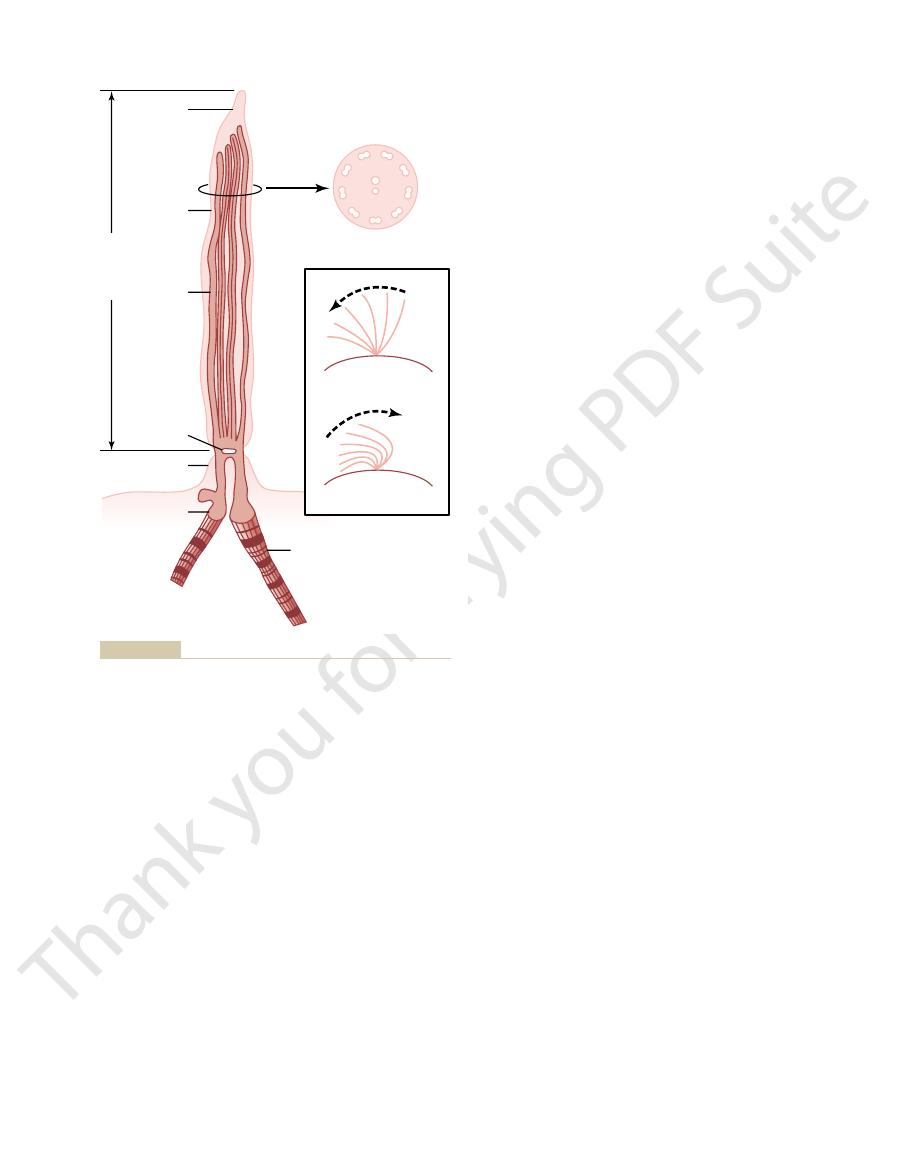
Cell 116:205, 2004.
Danial NN, Korsmeyer SJ: Cell death: critical control points.
76:1, 1996.
docking, and fusion: a molecular description. Physiol Rev
Calakos N, Scheller RH: Synaptic vesicle biogenesis,
and fusion. Cell 116:153, 2004.
Bonifacino JS, Glick BS: The mechanisms of vesicle budding
the Cell. New York: Garland Science, 2002.
Alberts B, Johnson A, Lewis J, et al: Molecular Biology of
arms.
signal, perhaps an electrochemical signal, is transmitted
cilia fail to beat. Therefore, it is presumed that some
do not have the two central single tubules, and these
understood. The cilia of some genetically abnormal cells
The way in which cilia contraction is controlled is not
tubules remain stationary, this will cause bending.
tubule. If the front tubules crawl outward while the back
“crawl” rapidly along the surface of the adjacent double
ATPase dynein arms causes the heads of these arms to
that the release of energy from ATP in contact with the
Given this basic information, it has been determined
tubule.
which has ATPase enzymatic activity, project
Fifth, multiple protein arms composed of the protein
cilium, while those on the back edge remain in place.
motion of the cilium, the double tubules on the front
of magnesium and calcium. Fourth, during forward
ionic conditions, especially appropriate concentrations
cilium: (1) the availability of ATP and (2) appropriate
still beat under appropriate conditions. Third, there are
ments of the cilium besides the axoneme, the cilium can
Second, even after
axoneme.
cross-linkages; this total complex of tubules and cross-
First, the nine double tubules and the two single tubules
ciliary movement are clear, we do know the following:
Mechanism of Ciliary Movement.
from one part of the surface to another.
direction, this is an effective means for moving fluids
in the direction of the fast-forward stroke. Because most
movement. As a result, the fluid is continually propelled
tion that the cilium moves; the slow, dragging movement
The rapid forward-thrusting, whiplike movement
Then it moves backward slowly to its initial position.
whiplike stroke 10 to 20 times per second, bending
shown. The cilium moves forward with a sudden, rapid
In the inset of Figure 2–17, movement of the cilium is
instead of whiplike movements.
of contractile mechanism. The flagellum, however, is
is similar to a cilium; in fact,
The
cell membrane, called the
section shown in Figure 2–17. Each cilium is an out-
tubules down the center, as demonstrated in the cross
located around the periphery of the cilium, and 2 single
covered by an outcropping of the cell membrane, and it
inside the respiratory passageways. The cilium is
cilia often project from a single cell—for instance, as
2 to 4 micrometers from the surface of the cell. Many
As shown in Figure 2–17, a cilium has the appearance
uterus.
the uterine tube toward the uterus cavity; this move-
become trapped in the mucus. In the uterine tubes, the
toward the pharynx, in this way continually clearing
layer of mucus to move at a rate of about 1 cm/min
ratory airways, the whiplike motion of cilia causes a
reproductive tract. In the nasal cavity and lower respi-
occurs in only two places in the human body: on the
Chapter 2
The Cell and Its Functions
25
sufaces of the respiratory airways and on the inside
surfaces of the uterine tubes (fallopian tubes) of the
these passageways of mucus and particles that have
cilia cause slow movement of fluid from the ostium of
ment of fluid transports the ovum from the ovary to the
of a sharp-pointed straight or curved hair that projects
many as 200 cilia on the surface of each epithelial cell
is supported by 11 microtubules—9 double tubules
growth of a structure that lies immediately beneath the
basal body of the cilium.
flagellum of a sperm
it has much the same type of structure and same type
much longer and moves in quasi-sinusoidal waves
sharply where it projects from the surface of the cell.
pushes the fluid lying adjacent to the cell in the direc-
in the backward direction has almost no effect on fluid
ciliated cells have large numbers of cilia on their sur-
faces and because all the cilia are oriented in the same
Although not all aspects of
are all linked to one another by a complex of protein
linkages is called the
removal of the membrane and destruction of other ele-
two necessary conditions for continued beating of the
axoneme after removal of the other structures of the
edge of the cilium slide outward toward the tip of the
dynein,
from each double tubule toward an adjacent double
along these two central tubules to activate the dynein
References
Tip
Cross section
Forward stroke
Backward stroke
Membrane
Filament
Cell
membrane
Basal body
Rootlet
Basal plate
Ciliary stalk
estate of Bunji Tagawa.)
Sci Am 204:108, 1961. Copyright Donald Garber: Executor of the
Structure and function of the cilium. (Modified from Satir P: Cilia.
Figure 2–17

Nicolson model. Proc Natl Acad Sci U S A 100:8053,
the cell membrane three decades after the Singer-
Vereb G, Szollosi J, Matko J, et al: Dynamic, yet structured:
Physiol 280:F739, 2001.
and transporters in cell migration. Am J Physiol Renal
Schwab A: Function and spatial distribution of ion channels
Biol 19:423, 2003.
Scholey JM: Intraflagellar transport. Annu Rev Cell Dev
integrating signals from front to back. Science 302:1704,
Ridley AJ, Schwartz MA, Burridge K, et al: Cell migration:
demic Press, 1998.
Perrios M: Nuclear Structure and Function. San Diego: Aca-
dimension of the nuclear envelope. Physiol Rev 81:1, 2001.
Mazzanti M, Bustamante JO, Oberleithner H: Electrical
Mol Cell Biol 5:121, 2004.
Maxfield FR, McGraw TE: Endocytic recycling. Nat Rev
endoplasmic reticulum. Nat Rev Mol Cell Biol 5:65,
Mattaj IW: Sorting out the nuclear envelope from the
Am J Physiol Cell Physiol 282:C1, 2002.
Lange K: Role of microvillar cell surfaces in the regulation
duction in living cells. Physiol Rev 81:685, 2001.
Hamill OP, Martinac B: Molecular basis of mechanotrans-
ribonucleoprotein maturation. Curr Opin Cell Biol 15:318,
Gerbi SA, Borovjagin AV, Lange TS: The nucleolus: a site of
bilayers. Nat Rev Mol Cell Biol 4:414, 2003.
Edidin M: Lipids on the frontier: a century of cell-membrane
Diabetes 53(Suppl 1):S96, 2004.
Duchen MR: Roles of mitochondria in health and disease.
function. Physiol Rev 82:47, 2002.
Dröge W: Free radicals in the physiological control of cell
Deutsch C: The birth of a channel. Neuron 40:265, 2003.
Introduction to Physiology: The Cell and General Physiology
26
Unit I
2003.
of glucose uptake and organization of energy metabolism.
2004.
2003.
2003.
